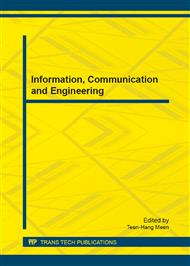[1]
Nguyen, H. T., J. B. Andersen, and G. F. Pedersen, "Characterization of the indoor/outdoor to indoor MIMO radio channel at 2.140 GHz," Wireless Personal Communications: AnInternational Journal, vol.35, p.289–309, November (2005)
DOI: 10.1007/s11277-005-6188-9
Google Scholar
[2]
Carpenter, T and J. Barrett, Certified wireless network Administrator official study Guide, Mc-Graw Hill, 2007.
Google Scholar
[3]
M. J. Gans, Y. S. Yeh, T. C. Damen, R. A. Valenzuela, and J. Lee, "Propagation measurement for fixed wireless loops (FWL) in a Suburban Region with Foliage and Terrain Blockages", IEEE Transaction on wireless communication, Vol. 1, No., 2, April (2002)
DOI: 10.1109/7693.994824
Google Scholar
[4]
Joshi, G. G., C. B. Dietrich, C. R. Anderson, W. G. Newhall, W. A. Davis, J. Isaacs, and G. Barnett, "Near-ground channel measurements over line-of-sight and forested paths," IEE Proc.Microw. Antennas Propag., Vol. 152, No. 6, 2005.
DOI: 10.1049/ip-map:20050013
Google Scholar
[5]
Abdulrahman, A. Y., T. A. Rahman, S. K. A. Rahim and M. R. Ul Islam, "Empirically Derived Path Reduction Factor for Terrestrial Microwave Links Operating at 15GHz In Peninsula Malaysia", Journal of Electromagnetic Waves and Application, Vol. 25, 23–37, (2011)
DOI: 10.1163/156939311793898369
Google Scholar
[6]
J. D. Parsons, "Mobile radio propagation channel", New York, Wiley, 2000 <To check D BOOK>
Google Scholar
[7]
Meng, Y. S., Y. H. Lee, and B. C. Ng, "Investigation of rainfall effect on forested radio wave propagation," IEEE AntennasWireless Propag. Lett., Vol. 7, 2008.
DOI: 10.1109/lawp.2008.922052
Google Scholar
[8]
Helhel, S., S. Ozen, and H. G¨oksu, "Investigation of GSM signal variation depending weather conditions," Progress In Electromagnetics Research B, Vol. 1, 147–157, 2008.
DOI: 10.2528/pierb07101503
Google Scholar
[9]
Meng, Y. S., Y. H. Lee, and B. C. Ng, "The effects of tropical weather on radio wave propagation over foliage channel," IEEETrans. Veh. Technol., Vol. 58, No. 8, 2009.
DOI: 10.1109/tvt.2009.2021480
Google Scholar
[10]
Malaysian Communications and Multimedia Commission (MCMC), http://www.skmm.gov.my.
Google Scholar
[11]
Ott, R. H., "Electromagnetic scattering by buried objects in the HF/VHF/UHF frequency bands," Progress In Electromagnetics Research, PIER 12, 371–419, 1996.
DOI: 10.2528/pier95092600
Google Scholar
[12]
Li, Y.-L., et al., "Scattering field for the ellipsoidal targets irradiated by an electromagnetic wave with arbitrary polarizing and propagating direction," Progress In Electromagnetics Research Letters, Vol. 1, 2008.
DOI: 10.2528/pierl07120610
Google Scholar
[13]
Meeks, M. L., "VHF propagation over hilly, forested terrain," IEEE Transaction on Antennas Propag., Vol. 31, No. 3, 483-489, 1983.
DOI: 10.1109/tap.1983.1143066
Google Scholar
[14]
CCIR, "Influences of terrain irregularities and vegetation on troposphere propagation," CCIR Report, 235-236, Geneva, 1986.
Google Scholar
[15]
Faculty of Electrical Engineering webssite: www.fke.utm.my
Google Scholar
[16]
Blas, J., P. Fern´andez, R. M. Lorenzo, and E. J. Abril, "A model for transition between outdoor and indoor propagation," Progress In Electromagnetics Research, 147–167, (2008)
DOI: 10.2528/pier08072101
Google Scholar
[17]
Alsehaili, M., S. Noghanian, A.-R. Sebak and D. A. Buchanan "Angle and Time of Arrival Statistics of a Three Dimensional Geometrical Scattering Channel Model for Indoor and Outdoor Propagation Environments", Progress In Electromagnetics Research, Vol. 109, 191-209, (2010)
DOI: 10.2528/pier10081106
Google Scholar
[18]
Yarkoni, N.and N.Blaunstein, "Prediction of propagation characteristics in indoor radio communication environments,"Progress In Electromagnetics Research, PIER 59, 151–174, 2006.
DOI: 10.2528/pier05090801
Google Scholar
[19]
Li, L. W., T. S. Yeo, P. S. Kooi, M. S. Leong, and J. H. Koh, "Analysis of electromagnetic wave propagation in forest environment along multiple paths," Journal of ElectromagneticWaves and Applications, Vol. 13, No. 8, 1999.
DOI: 10.1163/156939399x01212
Google Scholar
[20]
Martinez, D., F.Las-Heras, and R.G. Ayestaran, "Fast methods for evaluating the electric field level in 2D-indoor environments," Progress In Electromagnetics Research, PIER 69, 247–255, 2007.
DOI: 10.2528/pier06122105
Google Scholar
[21]
Kara, A. and E. Yazgan, "Modelling of shadowing loss due to huge non-polygonal structures in urban radio propagation," Progress In Electromagnetics Research B, Vol. 6, 123–134, 2008.
DOI: 10.2528/pierb08031209
Google Scholar
[22]
Li, Y. and H. Ling, "Numerical modeling and mechanism analysisof VHF wave propagation in forested environments using the equivalent slab model," Progress In Electromagnetics Research, PIER 91, 17-34, 2009.
DOI: 10.2528/pier09012306
Google Scholar
[23]
Hashim, M. H. and S. Stavrou, "Measurements and modelling of wind influence on radio wave propagation through vegetation," IEEE Trans.Wireless Commun., vol. 5, p.1055–1064, May 2006.
DOI: 10.1109/twc.2006.1633358
Google Scholar
[24]
Meng, Y. S., Y. H. Lee, and B. C. Ng, "Study of propagation loss prediction in forest environment," Progress In Electromagnetics Research B, Vol. 17, 117-133, 2009.
DOI: 10.2528/pierb09071901
Google Scholar
[25]
Bello, J. C. R, G. L. Siqueira, and H. L. Bertoni, "Theoretical analysis and measurement results of vegetation effects on path loss for mobile cellular communication systems," IEEE Trans. Vehicular Technology, vol. 49, no. 4, pp.1285-1293, (2000)
DOI: 10.1109/25.875242
Google Scholar
[26]
Saunder, S. R,. "Antennas and Propagation for Wireless Communication Systems". John Wiley & Sons, 2001.
Google Scholar


